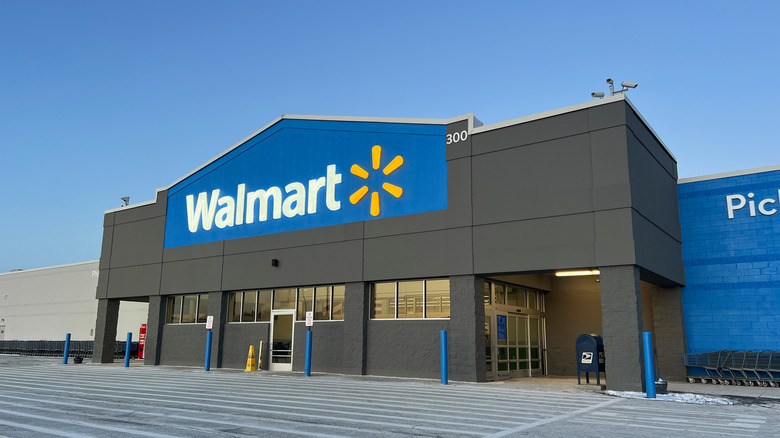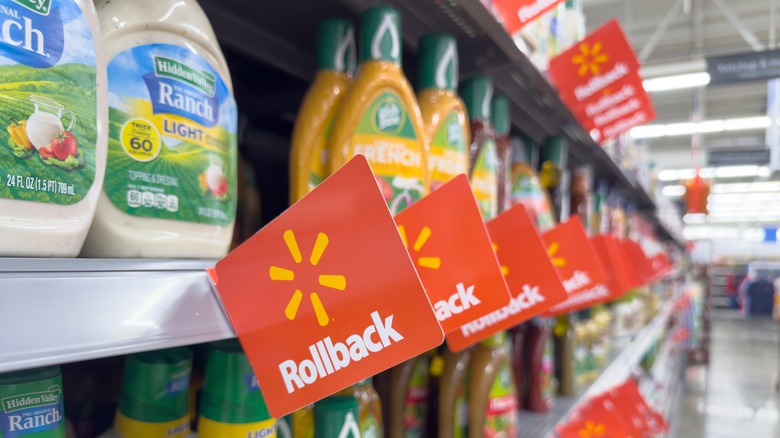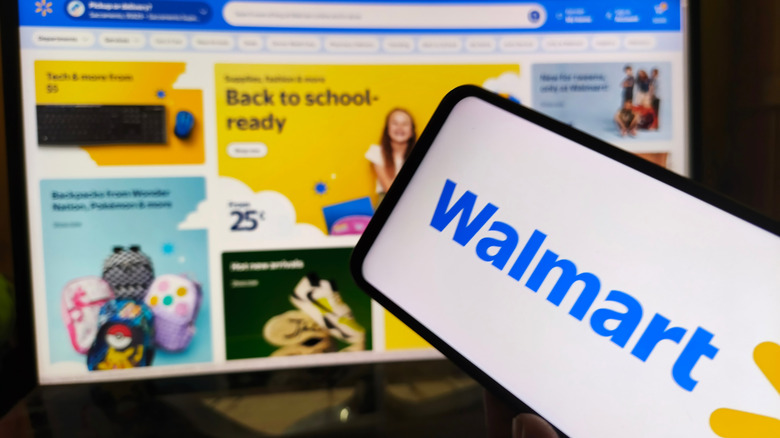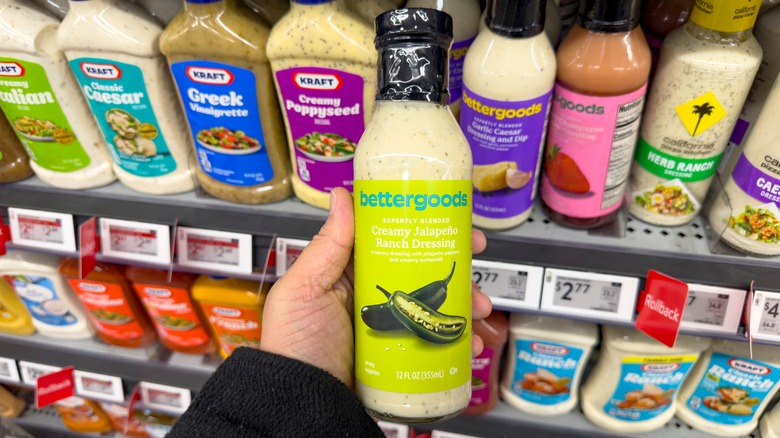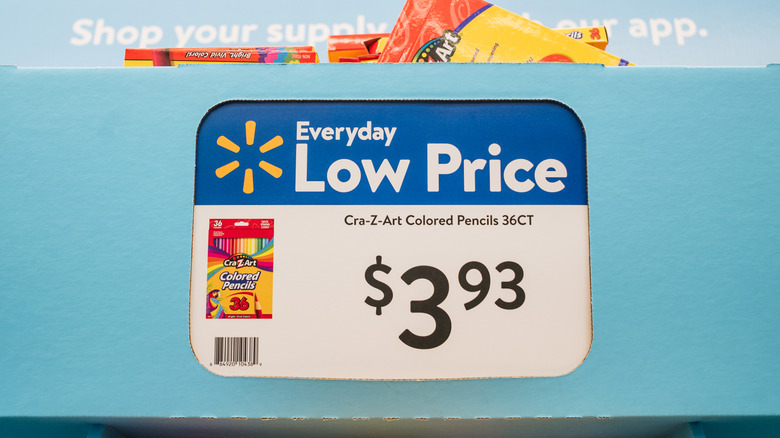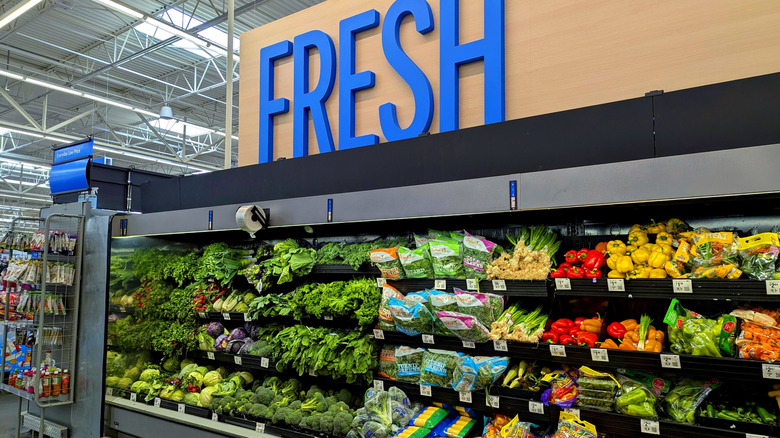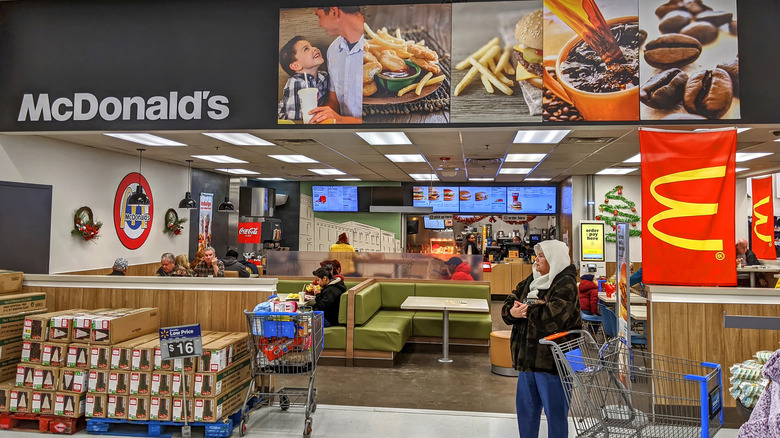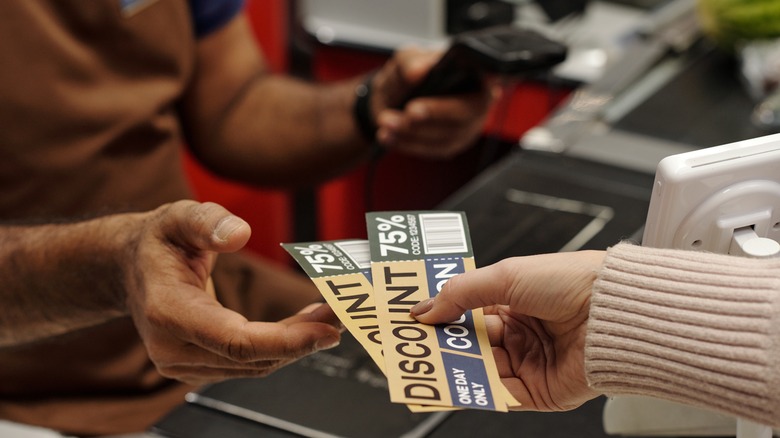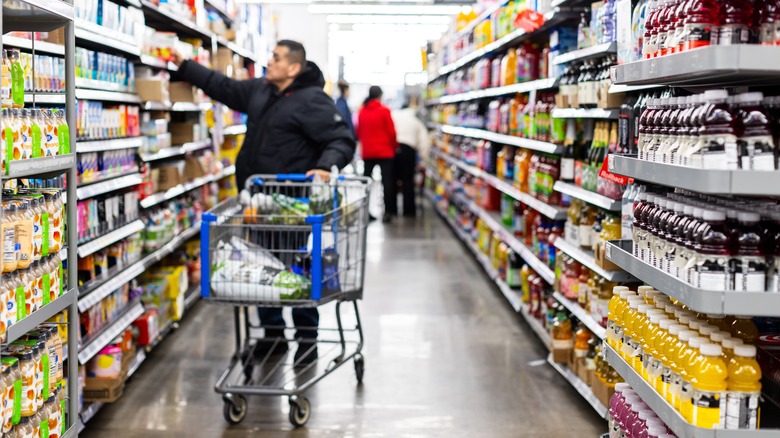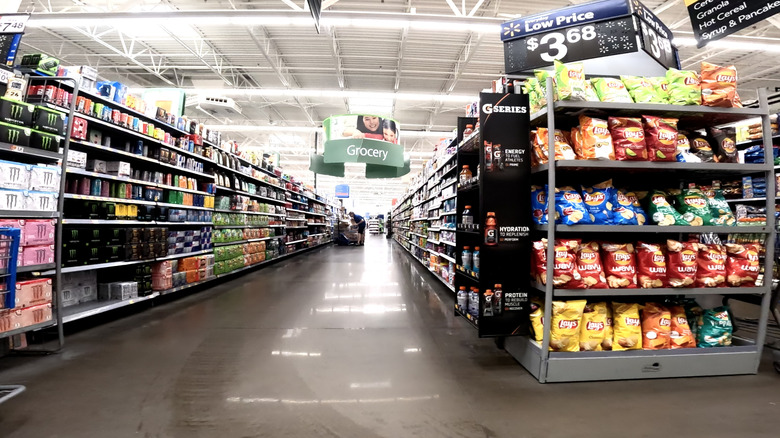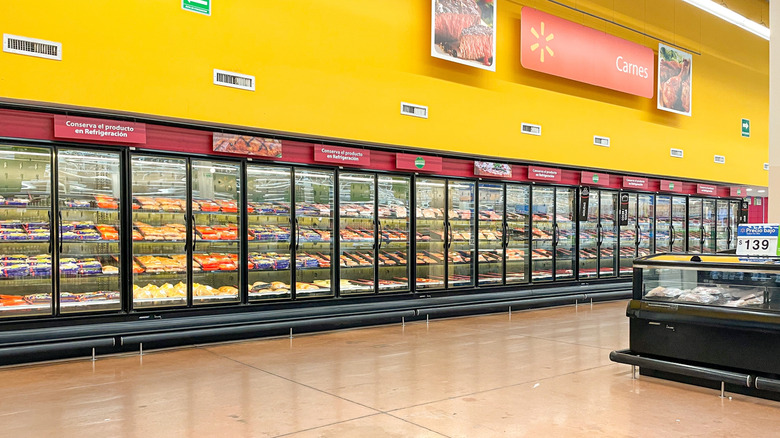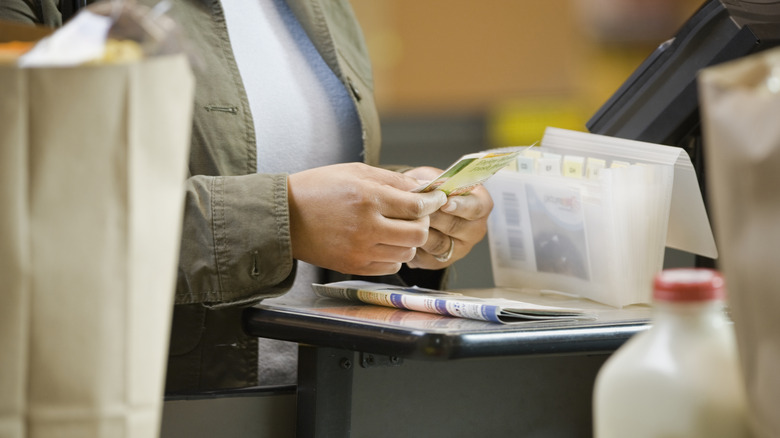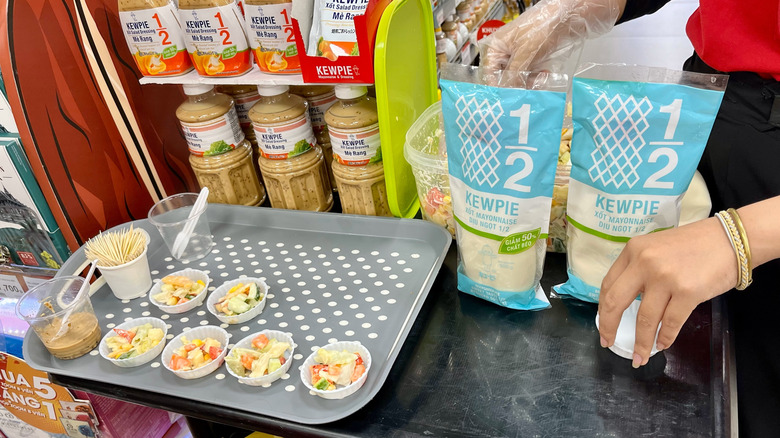False Things You Probably Believe About Grocery Shopping At Walmart
Whether you're a loyal Walmart shopper or just swing by for the occasional bulk buy, chances are you've formed some strong opinions about what the experience is like. With over 3,500 Walmart Supercenters in the U.S. alone — plus nearly 700 Walmart Neighborhood Markets — it's easy to feel like you know exactly what to expect with every visit. But there are some false things you probably believe about grocery shopping at Walmart.
Between online forums, viral TikToks, and long-held assumptions, there's a lot of half-truth and outdated information floating around about how this grocery giant really works. Some of the most common so-called "facts" — like the idea that its prices are always the lowest, or that every store stocks the same items — turn out to be more myth than reality once you dig into the details.
That's not to say Walmart doesn't live up to its rep in some ways. Yes, it's still a convenient, budget-friendly one-stop shop. But the ins and outs of grocery shopping there can be a little more nuanced than expected. If you want to shop smarter, it helps to separate the facts from the fiction. Here's what you might be getting wrong about grocery shopping at Walmart.
Walmart always has the absolute lowest prices on every item
Walmart built its empire on the promise of low prices, and for the most part, it delivers. But you shouldn't assume it's always the absolute cheapest option across the board. While the store is competitively priced, it isn't necessarily the bargain basement for everything. When you compare prices at various grocery stores, Aldi often comes out as the cheapest. Other supermarkets like Meijer and Kroger also sometimes have the cheapest price on a particular item.
While there's no one store where every item is the cheapest across the nation, when you look at the affordability of Aldi versus Walmart, Aldi is often the cheaper of the two. Of course, it does have a smaller selection and mostly stocks its own brands. You also need to take unit pricing into consideration when comparing prices. Walmart might offer a low price on a smaller item, but that doesn't mean it's the best value per ounce or per serving — particularly if you buy in bulk in places like Costco. Unless you're paying attention, it's easy to assume you're getting more for less when that's not always the case.
What it comes down to is that Walmart is often well-priced, but it's not always the cheapest. If you're a price-first shopper, the best strategy is still to compare across stores by breaking down cost-per-unit and factoring in store-brand alternatives.
The prices are the same in-store and online
You might assume that Walmart's website will mirror the prices you'll find at the store down the street, but what you see online isn't always what you'll get at the register. Prices between Walmart's website and its physical stores can differ, and often do.
It's not just a few cents, either. Depending on the item, online prices can be noticeably higher or lower than what you'd find in-store. That's partly because Walmart's website functions a bit like a marketplace. Some items are sold and shipped by third-party sellers, while others are stocked from Walmart's own inventory. Throw in regional pricing differences, and things get even more unpredictable.
This can be frustrating when you're browsing the app while shopping in person, and what you see on your screen doesn't line up with the shelf tag. Or when you spot something great online and think you'll save on shipping and get it faster by nipping to your local store instead. Luckily, price matching is available between anything found on Walmart.com and products found in Walmart U.S. stores. This is only available on identical products, though, and some restrictions do apply, with the final decision at the discretion of the store manager. So, it might be worth the effort when you've seen a TV for $100 less online than in-store, but probably not when the jar of pumpkin pie spice you're buying is $0.30 cheaper online.
Walmart's private label groceries are no good
Store brands don't always have the best reputation. But if you've been skipping Walmart's private label groceries based on old assumptions, you might be missing out. Brands like Great Value and Marketside have come a long way in recent years, and not just in terms of packaging. Many of Walmart's private label products are made by the same manufacturers behind big-name brands, just sold at a lower price. Walmart's Great Value range was once even voted the best grocery store private label in a Mashed poll.
What's more, the chain has moved into more premium territory. In 2024, Walmart launched Bettergoods, a new line focused on plant-based products, premium ingredients, and products made without certain ingredients, such as gluten or artificial flavors. The goal is to compete with the likes of Trader Joe's and Whole Foods, and surprisingly, these products are more than holding their own. Shoppers who once dismissed Walmart's store brands are now buying them on purpose — not as a budget compromise, but because they genuinely like the products. Walmart's private label products are currently doing better than ever, with the Bettergoods line racking up nearly $500 million in sales roughly a year after its launch. So, if you're still turning your nose up at Walmart's own brands, it might be time to reconsider. You may just find yourself with a new favorite product.
The prices are the same in every store
Many people think that every Walmart across the country charges the exact same amount for every product. This seems to make sense. After all, it's all the same chain, so wouldn't you expect that a shopping basket costs the same in each store? However, the truth is that prices at Walmart can — and do — vary from location to location.
The grocery chain uses regional pricing, meaning prices can vary depending on the local market, competition, and even supply chain factors. The most expensive Walmart groceries are in Hawaii, costing nearly 34% more than the national average, according to CashNetUSA. Alaskan groceries are almost as pricey, at just over 32% more than average. The cheapest state for Walmart shopping is Texas, where prices are nearly 5% below the national average.
Each store manages its own inventory, so managers have the power to raise or lower prices. It might run a clearance price on products that aren't selling well or put popular items on sale to compete with other stores. This means prices of some products may be cheaper at one location and pricier at another just a few miles away. So, don't assume your Walmart is identical to others around the nation. Each store is part of the same brand, but behind the scenes, there's more price flexibility than you'd think.
The quality of the produce is always bad
Walmart's produce section has long had a reputation problem – and, to be fair, it wasn't entirely undeserved. For years, customers complained about bruised fruit, wilted greens, and unpredictable freshness. But things have changed in recent years. Walmart has quietly overhauled how it sources and stocks fresh produce. So, it might be time to rethink your opinion of its produce.
The grocery store chain now works more directly with suppliers, including some local and regional farms, which helps shorten the supply chain and get fresher items on the shelves faster. This transformation also included technological investments like automated perishable distribution centers. These changes have contributed to major gains: some produce categories have doubled in sales, and the company has gained new customers.
While the experience can still vary by location, you can often find decent avocados, crisp lettuce, and seasonal fruit that rivals what's available at higher-end chains — usually for less money, too. If you've written off Walmart's produce based on a bad experience from a few years ago, it might be time to give it another look. No one's claiming it's a farmer's market, but it's at least on par with most other grocery chains.
McDonald's is the only in-store dining option
Grabbing a quick bite at Walmart used to mean heading straight for the in-store McDonald's. But over the past few years, the Golden Arches' monopoly has quietly faded. As more locations have closed since the COVID-19 pandemic, Walmart has started opening the door to more diverse in-store dining options.
Today, what you'll find inside Walmart can vary wildly depending on where you are. In some stores, express versions of Crave Hot Dogs & BBQ – a fast-casual spot serving customizable comfort food — have taken over the old McD's footprint. Others now feature pizza joints or poke bars.
The shift is partly about keeping up with changing food trends but also about giving shoppers more choice and a reason to linger. Walmart knows that if you're well-fed, you're more likely to shop longer and spend more. It's the same reasoning behind the growing number of Walmart locations with Starbucks kiosks and expanded grab-and-go sections. So, if you walk in expecting just burgers and fries, you may be surprised. It might just be worthwhile sticking around for dinner or picking up something to take home after a long evening of grocery shopping.
You can get cashback from couponing at Walmart
Extreme couponers, brace yourselves. Walmart has cracked down hard on one of the oldest tricks in the bargain-hunting book: getting cashback from coupon overages. While it used to be possible to stack deals in a way that actually earned you money at checkout, those days are officially over. Launched in 2023, Walmart's updated coupon policy put a firm stop to cashback from overage. That means if your coupon is worth more than the price of the item, the extra value won't be credited to your total. You also won't be able to apply that overage to other purchases, which was once a major draw for coupon-savvy shoppers.
And there's more. Store employees are no longer allowed to override system restrictions or manually adjust coupons at the register. That means fewer headaches for staff, but fewer loopholes for shoppers hoping to game the system. You can still use coupons, of course, but now they're processed strictly by the system. If they don't scan properly or meet Walmart's updated terms, they won't be accepted.
These changes don't make Walmart a bad place to use coupons. They just make it slightly less flexible than it used to be, and more on par with other national grocery retailers. But if you were hoping to save really big, those days are over.
High-income households don't shop at Walmart
It's easy to imagine Walmart as a budget destination reserved for bargain hunters on a tight income, but that stereotype is increasingly out of touch. In reality, Walmart's customer base is surprisingly broad, and high-income households are very much part of the equation.
Shopping data from Numerator shows that the average shopper is a middle-income earner of $40,000 to $125,000, with 28% of Walmart shoppers earning over $125,000 per year. For comparison, only 24% of its customers fall under the low-income bracket, earning less than $40,000 per year. Nearly 70% of its shoppers are also homeowners.
It just shows that convenience and value aren't exclusive to any one income bracket. Even those who can afford to shop elsewhere recognize the appeal of a one-stop shop with competitive pricing, fast checkouts, and solid private label options. This shift also reflects wider trends. With inflation and rising cost-of-living pressures, even wealthier shoppers are looking to stretch their budgets.
Walmart doesn't stock local or regional products
Walmart might be a national chain, but its shelves aren't filled with the same exact items in every store. In fact, one of the lesser-known sides of Walmart's grocery strategy is its growing support for local and regional suppliers, something you'll spot if you pay attention to the fine print on product labels. From locally baked bread to region-specific snacks, many stores carry items made by businesses in the same state or region.
This is part of Walmart's commitment to U.S. manufacturing and small supplier partnerships, which it has only expanded in recent years. There are even pre-defined routes for small producers to get their wares stocked in Walmart. Theoretically, that means a Walmart in Texas might stock barbecue rubs made nearby, while a Michigan store might carry jams from a local orchard or craft soda bottled in-state. It's not always prominently advertised, but they're part of a conscious effort to diversify the store's offerings beyond just national brands.
For shoppers, it's a nice bonus. You get to support local businesses without giving up the ease and price points that make Walmart so appealing. Next time you're browsing the aisles, take a closer look; you might find some great products from right on your doorstep.
You can only shop at Walmart in North America
It may feel all-American, but Walmart's reach extends far beyond the U.S., Canada, and Mexico. In fact, Walmart operates across the globe – just not always under the Walmart name. In Central America, you'll find the likes of Despensa Familiar and Paiz. In Chile, Walmart brands include Líder and Central Mayorista. Over in Africa, Builders, Game, and Jumbo — found in various countries, including Botswana, Eswatini, Namibia, Mozambique, and Zambia — all fall under the Walmart umbrella. It also used to be the primary stakeholder in Asda, a large U.K. supermarket chain, but it sold much of its stake in 2020.
These international outposts adapt to local tastes, shopping habits, and supply chains. They aren't just identical to U.S. Walmart stores. But the core values remain: convenience, competitive pricing, and a mix of national and private label brands. Walmart is influencing retail trends around the world. You might not see its iconic logo on your next vacation, but you could very well be walking into a Walmart-operated store without realizing it.
Walmart doesn't accept any manufacturer coupons anymore
If you've heard that Walmart has done away with external coupons entirely, don't worry. It hasn't stopped accepting these types of coupons but it did update its policy, and if you haven't kept up with the changes, it's easy to assume that everything got tossed out altogether.
Walmart still accepts most manufacturer coupons. What the chain has tightened up is the process. Coupons must scan cleanly, meet all redemption criteria, and cannot be manually overridden by a cashier. That means no expired coupons, no fuzzy barcodes, and no negotiating at checkout. The policy is now fully system-based; if the register doesn't accept it, it's out.
The confusion often stems from what Walmart doesn't accept: no competitor coupons, third-party coupons from the likes of Visa, and no digital coupons. If you're used to a more flexible, cashier-discretion kind of couponing experience, this might feel like a frustrating shift. But for most everyday shoppers using basic brand coupons, nothing has really changed, except the need to play by the rules a little more closely.
You can't get free samples at Walmart
When you think of free samples at a grocery store, your mind probably jumps to Costco, not Walmart. However, the latter has upped its sample game, meaning you no longer have to head to a warehouse store for the joy of scoring a free pizza roll or chocolate chip cookie — you might be able to do it on your regular grocery run.
In select stores — around 1,000 nationwide — Walmart has rolled out dedicated sample stations stocked with snacks, beauty products, and more. They're all designed to let customers try before they buy. The setup feels less like a random handout and more like a curated experience, with rotating selections based on product launches, seasonal themes, or promotions from national brands. You might get a single-serve coffee pod one week and a skincare sachet the next.
Not every location has a sample station yet, and availability can vary depending on the day or inventory. But if you're used to thinking of Walmart as sample-free territory, it's a pleasant surprise. And for those who prefer to shop online, you may even occasionally receive free samples with your grocery delivery or curbside pickup.
